If you want the best places to get close to gorillas and see one with your own eyes then you have to go Gorilla trekking in Africa where the best places to get close to gorilla in their own territory are found.
The only locations on earth where these incredible beasts can be found are in a small area that spans three countries; Rwanda, Uganda and the Democratic Republic of the Congo. Here they are concentrated in the Virunga Mountain Range which harbors Volcanoes National Park in Rwanda, Bwindi Impenetrable Forest in Uganda and the Virunga National Park in the DRC. These parks are interconnected and the gorillas roam freely between all three. The DRC is the least stable country politically, and for safety, currently we do not advise our travelers to trek here.
What to Expect | When You are Expecting to See a Gorilla (in Rwanda and Uganda)
It is every bit as exciting as your wildest dreams and being prepared will ensure you can make the most of it.
On the Day of your Gorilla Trek Safari
- There will be an early start to get you to the park offices by 7 am. Coffee and tea are available.
- Visitors all meet and are assigned to the various gorilla families.
- At around 7:30AM you will be called to your group and you will go to your assigned gorilla family’s specific briefing area.
- The two gorilla guides who will go out with you will now brief you by introducing themselves, telling you more about the gorilla family you have and providing you with general tips and guidance. All the do’s and dont’s will be covered.
- (While you are at the park offices gorilla trackers have already left the park early in the morning to find the families that will meet the visitors and so, you will be directed to the park entrance closest to your family to make the trek shorter.)
- Porters will wait at your designated park gate. We have included this service for all of our guests as using them assists the community and it allows you negotiate the soft and sliding volcanic soil, thick vegetation, rivers and streams, barbed branches, stinging nettles, bamboo thickets, extreme undergrowth, and slippery mud. Porters can also create miracles for people who dream of visiting gorillas but are not physically able to trek to them. They have even carried people on stretchers through the forest.
- Trekking inside the park boundaries is hard work and so you might stick to farmland on the boundary until you have to enter the park. The trek might last an hour but could be several or an entire day. Your group is escorted by park rangers, who will carry guns for your protection. Your trackers will wait within a few meters from the gorillas and you will have a quick reminder of the do’s and dont’s. You will smell the gorillas before you see them. You will leave all your belongings with the trackers while you spend time with the gorillas (this is to protect the natural habitat and way of life of the gorillas by keeping human food away from them).
- You will now have one hour with your family. You can move with them and the experience remains dynamic.
- At the end of the hour, guides and visitors depart while the trackers stay behind collecting data and observing where the gorillas make their beds for the night.
- You trek back to the closest park gate (which might be far away). You can tip your guides, park rangers, and porters when you arrive at your pick-up car.
Do’s and Dont’s of Gorilla Trekking
Mountain gorillas are wild, but the families introduced to tourists are habituated for years and they do not perceive us as a threat.
The golden hour is strictly adhered to in order to preserve the natural gorilla activities.
Age requirements for gorilla trekking
In order to go on your gorilla trekking tour, you need to be at least 15 years old in Uganda and 16 years old in Rwanda.
Although you can take as many photographs and videos as you like, you cannot use flash photography as this could scare the gorillas and cause them to react violently.
Only 1 hour a day
Habituated gorilla groups spend only one hour a day with visitors. The golden hour is strictly adhered to in order to preserve the natural gorilla activities.
Guests are requested to stay 22 ft (7 m) from the gorillas although this is not always entirely practical and depending on the forest, the guides and the silverback, you may get much closer. IF a gorilla approaches you the guide will talk to them to make them back off.
Quiet, calm and non-threatening
Always remain calm and quiet. Never make direct eye contact with a silverback.
No cold or disease
Gorillas share almost all our DNA but none of our resistance. A simple cold could kill them. If you feel unwell your trek will be rescheduled.
Rwanda Gorilla tours | What is Unique about Gorilla Trekking in Rwanda
- One-third of all Mountain Gorillas live in Volcanoes National Park between altitudes of 7,545 and 14,760 ft (2,300 and 4,500 m).
- Rwanda has a dozen habituated gorilla families. Other families are set aside for research or are simply wild.
- Each family can be visited by a maximum of eight guests for an hour every day. On the mountain, the only way for a silverback to have his own family is to fight a dominant silverback or to leave and poach females.
- When a new family is formed or a baby born, they are given a name as part of the gorilla naming ceremony Kwita Izina that takes place yearly.
Where to Stay when you are Gorilla Trekking in Rwanda
The Brand New Gorilla’s Nest has recently opened on the foothills of the Virunga Volcano range in Rwanda.
This resort is the closest accommodation to the world-famous Volcanoes National Park… and the mountain gorillas that call the park home. It is also a seasoned modern traveler’s dream with an emphasis on wellness that draws on African botanicals and exceptional dining amid fragrant eucalyptus forest, exotic birds and a flourishing rose garden.
It is the region’s ultimate luxury resort and from here you can spend time with the mountain gorillas or indulge in a range of jungle activities.
What is Unique About Mountain Gorilla Trekking in Uganda
In Uganda, Mountain gorillas only live in the dense vegetation of Uganda’s Bwindi Impenetrable Forest National Park and Mgahinga (Place of Darkness). You can trek for gorillas in both locations.
Uganda has 15 habituated gorilla families. Each family can be visited by a maximum of eight guests for an hour every day.
In Uganda, there are also two groups undergoing habituation, a process that introduces human presence to the family. These groups can be trekked on the one-of-a-kind Gorilla Habituation Experience Program, where you spend four hours with a family, observing them and staying near in order for them to be more relaxed in human presence. This experience is an all-day trek.
Where to Stay in Uganda
Stay at Clouds Mountain gorilla Lodge in Bwindi Impenetrable Forest National Park for a slice of heaven. Aptly named and wonderfully welcoming it walks the fine line between luxury and comfort with style. It is remote and intimate and at over 6500 ft (2000 m) it is also Uganda’s highest lodge.
Every cottage has a large sitting room with a fireplace, overstuffed armchairs and the work of Uganda’s best artists adorn the walls. Your every need is met by a personal butler.
History of Gorillas
The first gorilla ever to be seen alive in the wild was found by Paul Du Chaillu in his travels through western equatorial Africa between 1856 and 1859.
Mountain gorillas evolved together with humans but they kept a very low profile until a German Army Officer named Captain Robert von Beringe went to meet the Sultan Msinga of Rwanda and killed two in the jungles of Congo in 1902. The scientific name is Gorilla beringei beringei in his honor.
There are Western gorillas and Eastern gorillas (both species are critically endangered) depending on which side of the Congo they live on.
The Types of gorillas
Eastern gorilla Subspecies
The Mountain gorilla and the Grauer gorilla. – Mountain gorillas have thicker and longer hair for protection.
Western gorilla Subspecies
The Western Lowland gorilla (living in Cameroon, Gabon, the DRC, Congo, Angola or Equatorial Guinea) and the Cross-Border gorilla (living on the border between Nigeria and Cameroon).
The Cross-River gorilla is the most scarce and Western Lowland gorillas the most numerous. The Mountain gorilla is the only population showing good, steady growth.
Reasons why gorillas are on the critically endangered list
- Loss of habitat as a result of human development, uncontrolled logging and mining projects and subsistence farming
- Hunted for bushmeat or as trophies or pets
- Diseases are also a threat to the gorilla populations across Africa, especially Ebola and other human illnesses
- Mountain Gorillas have a slow reproduction cycle
The Silverback
A silverback is a male gorilla that has turned 12 which is the age when their shiny black fur starts to turn grey. All subspecies of gorillas have silverbacks. The silverback is the only member of the family allowed to mate with the female gorillas. There can be more than one silverback in a family.
When a young gorilla male reaches maturity he usually has to leave his group to avoid mating with his family members.
Other mountain gorilla facts
- Mountain Gorillas are the largest living apes.
- Baby gorillas have a mortality rate of 30% and remain with their mothers for three years.
- Gorillas are incredibly shy, intelligent, peaceful creatures with individual personalities. They are also 8-9 times stronger than humans.
- Their only predator is humans.
- They are herbivores who eat 44 – 66 pounds (20- 30 kg) a day of the fruits, seeds, leaves, shoots, and vines they find. They can occasionally eat insects. They never eat meat and they don’t drink water.
- They build a new tree nest to sleep in every night.
- They can be identified by their nose print.

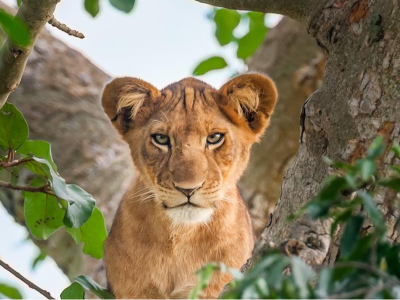
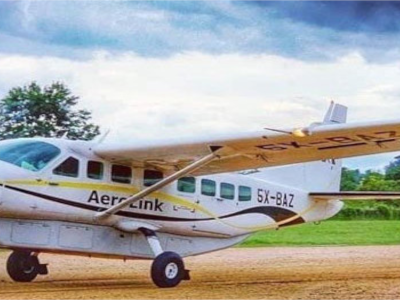
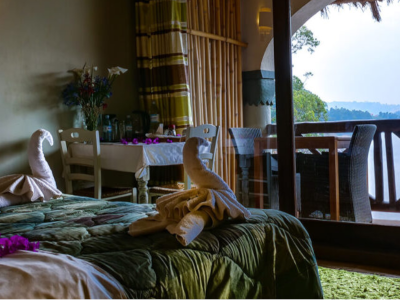

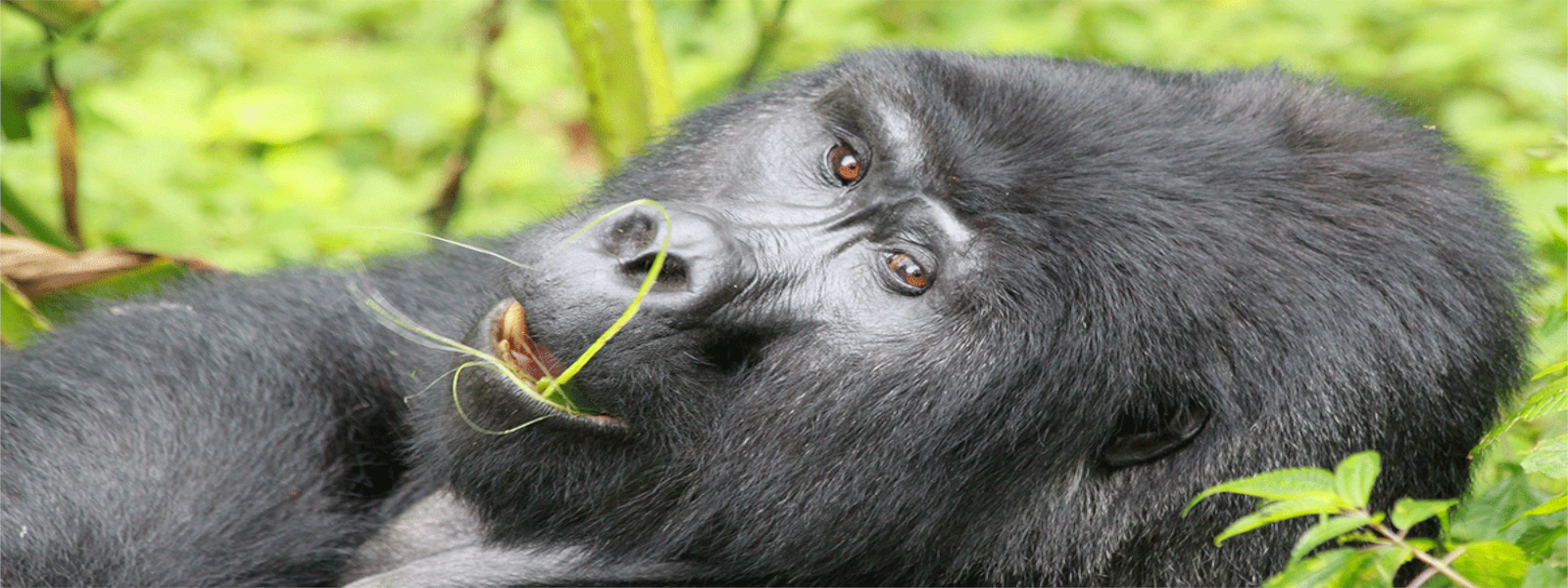
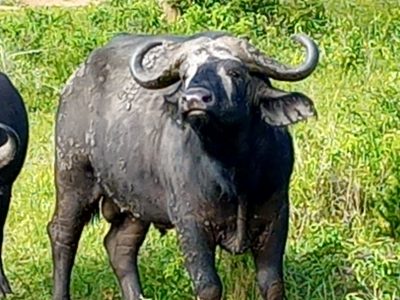


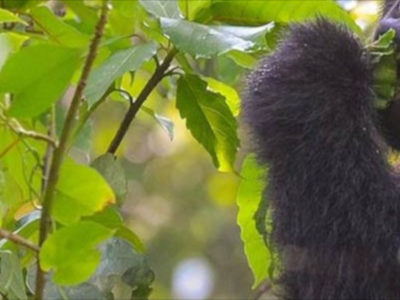
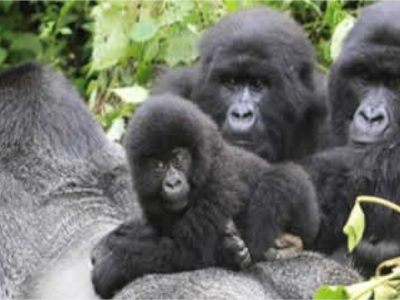

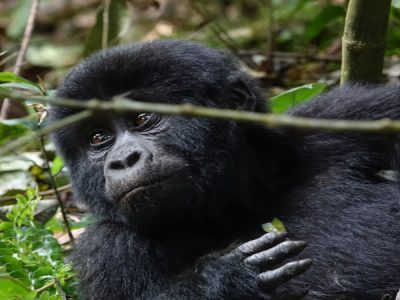

You must be logged in to post a comment.